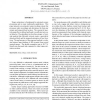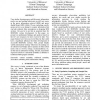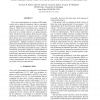ISMIR
2004
Springer
14 years 4 months ago
2004
Springer
In this paper, we investigate the impact of machine learning algorithms in the development of automatic music classification models aiming to capture genres distinctions. The stu...
ISMIR
2004
Springer
14 years 4 months ago
2004
Springer
This paper describes the development of a polyphonic music retrieval system with the n-gram approach. Musical n-grams are constructed from polyphonic musical performances in MIDI ...
ISMIR
2004
Springer
14 years 4 months ago
2004
Springer
This article explores the role visual browsing can play within a digital music library. The context to the work is provided through a review of related techniques drawn from the �...
ISMIR
2004
Springer
14 years 4 months ago
2004
Springer
This paper proposes to use the techniques of Music Information Retrieval in the context of Music Interaction. We describe a system, the SongSampler, inspired by the technology of ...
ISMIR
2004
Springer
14 years 4 months ago
2004
Springer
We propose a general approach to discriminant feature extraction and fusion, built on an optimal feature transformation for discriminant analysis [6]. Our experiments indicate tha...
ISMIR
2004
Springer
14 years 4 months ago
2004
Springer
The systematic testing of the very many parameters and algorithmic variants involved in the design of high-level music descriptors at large, and similarity measure in particular, ...
ISMIR
2004
Springer
14 years 4 months ago
2004
Springer
Tempo estimation is fundamental in automatic music processing and in many multimedia applications. This paper presents an automatic tempo tracking system that processes audio reco...
ISMIR
2004
Springer
14 years 4 months ago
2004
Springer
User studies focusing upon real-life music information needs, uses and seeking behaviours are still very scarce in the music information retrieval (MIR) and music digital library ...
ISMIR
2004
Springer
14 years 4 months ago
2004
Springer
An audio fingerprint is a compact representation of the perceptually relevant parts of audio content. A suitable audio fingerprint can be used to identify audio files, even if ...
ISMIR
2004
Springer
14 years 4 months ago
2004
Springer
Time series representations are common in MIR applications such as query-by-humming, where a sung query might be represented by a series of ‘notes’ for database retrieval. Whi...



